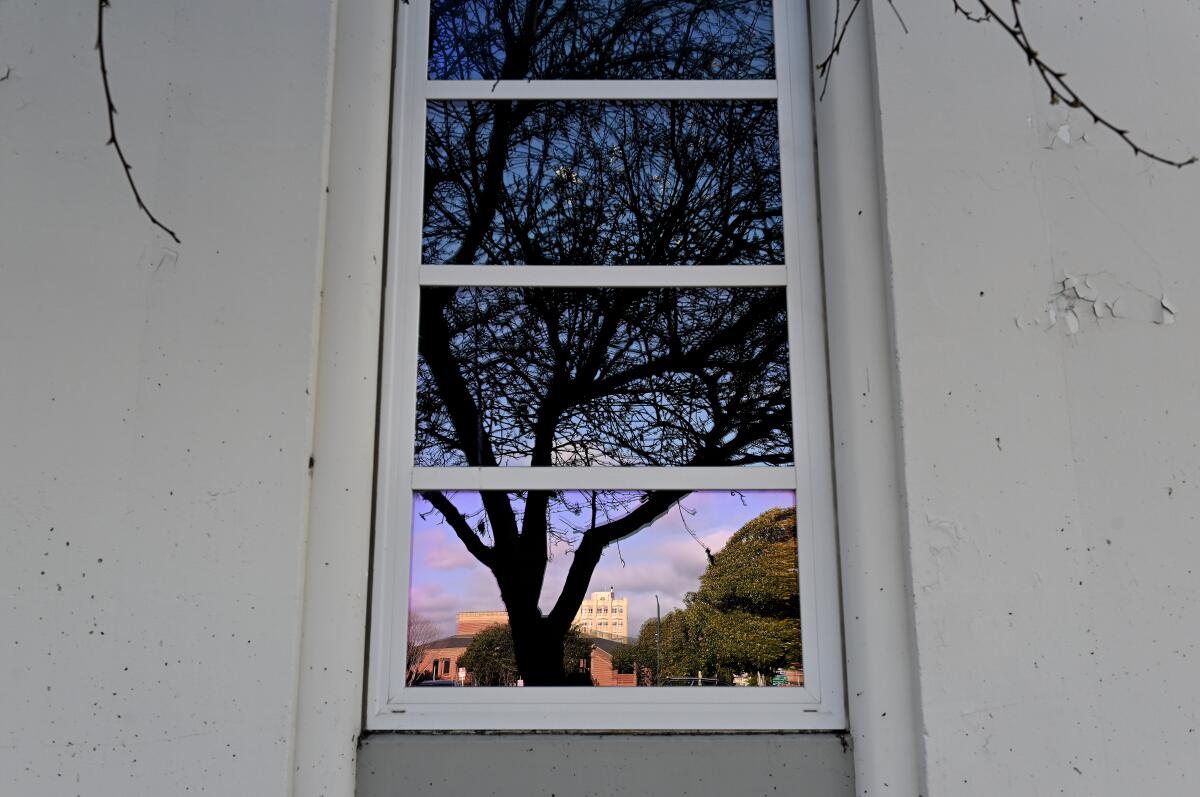The California newspaper that has no reporters left

SALINAS — When brown water overflowed the banks of the Salinas River in January, flooding thousands of acres and throwing an untold number of farmworkers out of jobs, the leading newspaper in this agricultural mecca did not cover the story.
Candidates in the November race for mayor also went absent from the pages of the 152-year-old news outlet. Ditto non-coverage of a police staffing shortage so serious that the police chief said the department might not have enough cops to respond to all complaints of theft, fraud, vandalism, prowling and prostitution.
The Salinas Californian missed those stories, understandably, because it employed only one journalist until December. That’s when the paper’s last reporter quit to take a job in TV. The departure marked the latest and perhaps final step in a slow-motion unwinding of what used to be the principal local news source in this city of 163,000.
Owned by the largest newspaper publisher in the nation, Gannett, the venerable Californian now carries stories from the chain’s USA Today flagship and its other California papers. The only original content from Salinas comes in the form of paid obituaries, making death virtually the only sign of life at an institution once considered a must-read by many Salinans.

The lack of local reporting has drawn complaints from the mayor, a county supervisor and everyday citizens who say the public life of their community has been diminished by the lack of a dependable source of local news.
“As a subscriber, seems like they are all gone & all local news has vanished from its pages! The end of an era??” Monterey County Supervisor Luis Alejo recently wrote on Twitter, adding in another tweet: “Hoping they were hiring others soon instead of giving up on serving our community.”
Trish Triumpho Sullivan, owner of Salinas’ Downtown Book & Sound, said the newspaper’s retreat feels especially ironic in the hometown of John Steinbeck, the Nobel Prize-winning novelist who once worked as a war correspondent.
“He understood the power of a story to create positive change,” said Sullivan, who has lived in Salinas for more than 40 years. “Without a local paper in our city, we’ve lost the power to tell the stories of people in our city and the city itself. We’ve lost the power of storytelling.”
An editor who previously helped oversee the Salinas paper from another Gannett newsroom 300 miles north referred questions to the company’s corporate office in McLean, Va.

“The Californian has deep roots in Monterey County and the greater Monterey Bay area,” Lisa Strattan, senior director of the company’s Center for Community Journalism, said in a statement. “And we remain committed to providing resources to our newsroom while relying on our USA Today Network to ensure continued coverage.”
The company’s corporate PR office acknowledged “staffing challenges in certain newsrooms” but pledged that Gannett is “developing strategies to support these markets, including communities such as Salinas.” None of the 57 reporting jobs recently listed on the chain’s online hiring board were for work in Salinas.
The emptying of the Californian’s newsroom epitomizes the ongoing struggles for the American newspaper industry, a shift felt acutely at small-town papers. Newspaper revenue nationally plummeted 52% from 2002 to 2020, with much of the income from advertising shifting to Internet giants such as Google and Facebook. In the dozen years after 2008, newspaper newsroom employment fell 57%.
Gannett’s downsizing accelerated after the company’s 2019 merger with GateHouse Media to form a company that owns roughly one-fifth of all daily newspapers in America. Gannett employed 11,200 people at the end of 2022, regulatory filings showed, a 47% decline from three years prior.
It took years of layoffs and dispirited resignations for the Salinas Californian staff to finally tick down to zero.

The Californian’s newsroom buzzed with about 35 journalists in 1999 — and not just hard news reporters but writers specializing in sports and features and a separate opinion department, a former editor recalled. The paper staffed the major beats and looked after the public’s business, from the City Council and local schools to crime and downtown development.
When President Clinton made an election-season stop in 1996, for instance, his campaign did not pick up the $50,000 in overtime for Salinas police and sheriff’s deputies. The paper dogged the White House until the president’s reelection campaign coughed up the money, recalled then-editor Catharine Hamm, adding: “That was such sweet justice.”
With advertising, production and other operations included, the newspaper employed about 120 people. But when the Great Recession hit, ad sales swooned and the staff shrank by about a third. By 2016, the paper had gone from six days a week in print to three. The following year, it moved out of its historic downtown building, graced to this day by a mural of Steinbeck superimposed over the Californian’s front pages.
Still, with a handful of reporters and a photographer, the Californian managed to write about challenges such as housing and homelessness. Reporter Kate Cimini chronicled the rising cost of death, most poignantly with the story of a onetime Salinas activist, terminally ill, who had to raise money to pay for her own impending funeral.
The newspaper also could inspire, in one instance with news of a local 14-year-old who became the second-youngest player to sign a professional contract with Major League Soccer; in another, with the story of a Zapoteco farmworker who at the age of 58 earned a college degree from Cal State Monterey Bay.

Still, by last year, the Californian’s staff had been gutted. As reporters left for other papers or got out of the business altogether, there was no move to replace them. By then, the paper’s print circulation — 11,000 on Saturdays a decade ago — had slipped to about 2,500.
Salinas is not the first city where Gannett has let a newsroom wither. The weekly Mt. Shasta News has no full-time local reporters, relying on freelancers and a Gannett daily in Redding, one of the chain’s editors said. Axios reported in January that the St. Cloud Times in Minnesota, after 93 years in publication, had lost its last reporter.
Journalists inside Gannett have seethed as the company devoted money to other priorities, including compensation for CEO Mike Reed of nearly $8 million and a plan to buy back up to $100 million of the company’s stock.
“The journalists at these papers are at their wit’s end,” said Jon Schleuss, president of the NewsGuild, a unit of the Communications Workers of America. “The way that you run and grow a news business is you employ local journalists who cover stories that the community cares about.”
The erosion of the Californian’s local staff also sapped its sister publication, El Sol, a Spanish-language outlet that translated the paper’s work. Gannett quietly shut down El Sol last September.
What happens when a town loses its local news?
In Salinas, it’s meant high school athletes lost a marquee platform. The struggles and triumphs of the immigrants who labor in the region’s storied lettuce and strawberry fields have gone unreported. No more shared celebration of community events, or stirring coverage of the crowds showing up hungry at food banks in a region teeming with agricultural bounty.
The list of missing stories only grew in recent weeks: an unidentified man run over and killed by a train in early March; a court order against a labor contractor to pay $460,000 in back wages and penalties to farmworkers; a dispute over whether the Saturday shutdown of Main Street is hurting businesses.

Sullivan, the bookstore owner, launched a petition opposing the street closure, saying it has cost her and other merchants dearly. In the old days, the Californian would have covered the issue and likely printed her letter of protest, she said. But no more.
“It’s all the local happenings that aren’t covered; the watchdog on local government and the politicians that is missing,” Sullivan said. “No one is looking at conflicts of interest. They could be running wild. … Now we’re left reading the tweets of people who go to City Council meetings.”
Dennis Donohue, a former Salinas mayor who heads an incubator for agricultural technology, said the community is missing an objective and trusted information source to help frame important public policy debates. “There’s a void in the daily life of the community,” Donohue said, “not having that constructive presence.”
Prominent new-media guru Ken Doctor promised to help replace disappearing newspapers. His 2-year-old startup, Lookout, is fighting for a foothold in Santa Cruz.
Locals have turned to other outlets. Many said they now look primarily to the Monterey County Weekly for news. The Monterey Herald, owned by the rival MediaNews Group, covers county news and some Salinas stories. KSBW-TV focuses on the Central Coast and offers highlights of high school sports.
A group of journalists from the region founded Voices of Monterey Bay in 2017 to try to fill the gap. Its stories, though infrequent, sometimes look at weighty issues such as the harm “pesticide drift” poses for vulnerable residents. The outlet’s early coverage of COVID-19, translated into Spanish, attracted many readers and proved the continuing high demand for quality information, said Claudia Meléndez Salinas, a Voices founder and former reporter at the Californian.
But Salinans said none of the other news outlets focus on their community with the intensity the Californian once did.
Per the new normal, the only local news in the Californian on a recent Wednesday was five paid obituaries. “I am not being macabre, but if you ask a lot of people, that is the main reason they would buy the paper,” said Jim Helm, a longtime swim coach. “But Salinas is the county seat. It’s a big town. I don’t know why they can’t come up with something more.”
Mary Duan, a former editor of the Weekly, said its hard to know what stories are being missed because reporters are not on the beat, asking questions, filing public records requests.
“They say democracy dies in darkness,” Duan said. “And we are in absolutely dark times in Salinas.”
More to Read
Sign up for Essential California
The most important California stories and recommendations in your inbox every morning.
You may occasionally receive promotional content from the Los Angeles Times.












